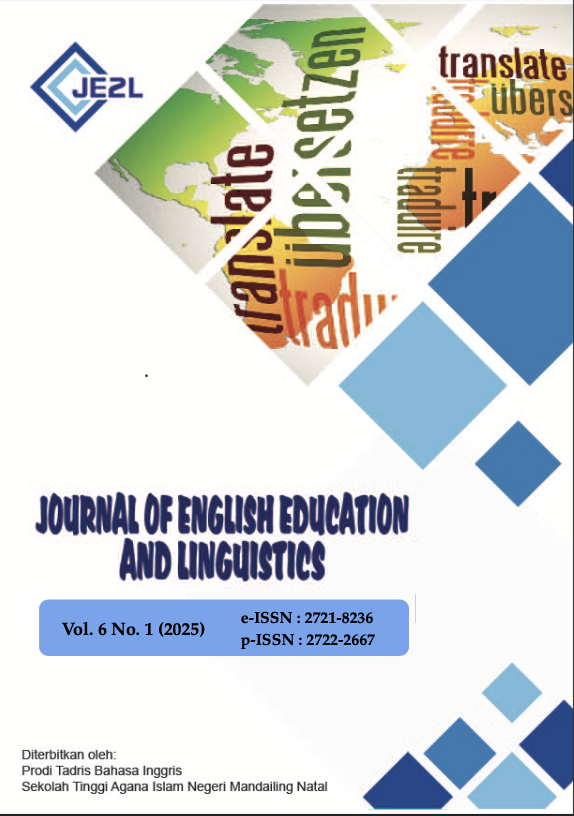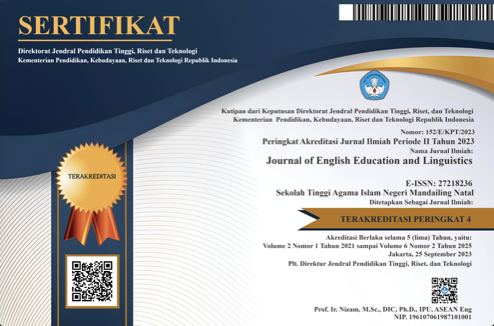FOSTERING CRITICAL THINKING IN ENGLISH LEARNING: AN ANALYSIS OF ENGLISH FOR NUSANTARA TEXTBOOK
DOI:
https://doi.org/10.56874/jeel.v6i1.2135Keywords:
Critical Thinking, English, Textbook, Critical Discourse AnalysisAbstract
This study investigates how the “English for Nusantara” Grade IX textbook shapes students’ critical thinking skills by using a Critical Discourse Analysis (CDA). As part of Indonesia’s goals in education, English for Nusantara published by the Indonesian Ministry of Education, Culture, Research, and Technology aims to integrate local cultural values with English language learning, promoting both linguistic skills and critical thinking skills. The research focused on analyzing the discourse in the textbook, including the languages and activities, to evaluate their potential in shaping students’ critical thinking skills. This study using Ilyas’ frameworks as the main analysis to see the indicators for the critical thinking. The study examined whether the textbook contains languages or activities that promotes the indicators; there are (1) clarification; (2) assumption; (3) reasons and evidence; (4) viewpoints or perspectives; (5) implications, consequences, and alternatives; (6) questions; (7) predictions; (8) agreement and disagreement; (10) summary and conclusion. The results showed that eight out of the ten indicators of critical thinking by Ilyas were applied in this textbook. It is also found that this textbook promotes critical thinking linked with the indicators by Facione, called self-regulation.
References
Alek, A. (2019). Discourse analysis. In The Routledge Handbook of Linguistic Ethnography. https://doi.org/10.4324/9781315675824-3
Alfadda, H., Fatima, M., Ghaffar, A., & Afzaal, M. (2020). Critical Thinking Perspective in ESL New English Textbooks: A Case Study of Pakistan. International Journal of Applied Linguistics and English Literature, 9(2), 24. https://doi.org/10.7575/aiac.ijalel.v.9n.2p.24
Alfira, D. W., Noni, N., & Korompot, C. A. (2022). EFL Students ’ Critical Thinking Skills?: The Perceptions of SMA IT Wahdah Islamiyah Makassar Teachers and Students. Journal of Excellence in English Language Education, 1(1).
Arifin, S. (2020). The Role of Critical Reading to Promote Students’ Critical Thinking and Reading Comprehension. Jurnal Pendidikan Dan Pengajaran, 53(3), 318. https://doi.org/10.23887/jpp.v53i3.29210
Bahadur, L. (2012). Critical Thinking in EFL Classrooms. ELT Today, 6(July).
Cojocariu, V.-M., & Butnaru, C.-E. (2014). Asking Questions – Critical Thinking Tools. Procedia - Social and Behavioral Sciences, 128, 22–28. https://doi.org/10.1016/j.sbspro.2014.03.112
Errington, A., & Bubna-Litic, D. (2015). Management by Textbook: The Role of Textbooks in Developing Critical Thinking. Journal of Management Education, 39(6), 774–800. https://doi.org/10.1177/1052562915594839
Es-Salhi, A., & Elfatihi, M. (2019). Evaluating Critical Thinking Skills in Moroccan EFL Textbooks: Gateway to English 2 as a Case. Higher Education of Social Science, 17(1), 13–22. https://doi.org/10.3968/11284
Facione, P. a. (2011). Critical Thinking?: What It Is and Why It Counts. In Insight assessment (Issue ISBN 13: 978-1-891557-07-1.). https://www.insightassessment.com/CT-Resources/Teaching-For-and-About-Critical-Thinking/Critical-Thinking-What-It-Is-and-Why-It-Counts/Critical-Thinking-What-It-Is-and-Why-It-Counts-PDF
Fairclough, N. (2004). Analysing Discourse: Textual Analysis. In Linguistics and Education (Vol. 15, Issue 3). https://linkinghub.elsevier.com/retrieve/pii/S0898589805000161
Gee, P. J. (2015). Unified Discourse Analysis.
Hamiloglu, K., & Temiz, G. (2012). in the World the Impact of Teacher Questions on Student Learning in Efl. Journal of Educational and Instructional Studies, 2(2), 1–8.
Hasanah, M., Silangit, S. Z. P., Jamil, R. P., & Amanda, W. N. (2023). Analisis Tingkat Kemampuan Berpikir Kritis Siswa Sma Nurul Iman Tanjung Morawa. Pedagogi: Jurnal Ilmiah Pendidikan, 9(1), 16–22. https://doi.org/10.47662/pedagogi.v9i1.540
Hasnah, Y., Ginting, P., Supiatman, L., Kharisma, A. J., & Siahaan, H. S. (2024). How Do Locally Produced EFL Textbooks Endorse Critical Thinking Skills in Indonesia? A Content Analysis. Journal of Language Teaching and Research, 15(1), 190–200. https://doi.org/10.17507/jltr.1501.21
Hazaea, A. N. (2020). Fostering critical intercultural awareness among efl students through critical discourse analysis. Ikala, 25(1), 17–33. https://doi.org/10.17533/udea.ikala.v25n01a06
Heard, J., Scoular, C., Duckworth, D., Ramalingam, D., & Teo, I. (2020). Critical Thinking?: Skill Development Framework. Australian Council for Educational Research, September 2021, 1–23.
Heidari, K. (2020). Critical thinking and EFL learners’ performance on textually-explicit, textually-implicit, and script-based reading items. Thinking Skills and Creativity, 37(July), 100703. https://doi.org/10.1016/j.tsc.2020.100703
Huang, P. (2019). Textbook interaction: A study of the language and cultural contextualisation of English learning textbooks. Learning, Culture and Social Interaction, 21(December 2018), 87–99. https://doi.org/10.1016/j.lcsi.2019.02.006
Ilyas, H. P. (2015). Critical thinking: Its representation in Indonesian ELT textbooks and education. York University, York Univ., 347. http://etheses.whiterose.ac.uk/12688/1/Final Thesis - Hamzah Puadi Ilyas.pdf
Ilyas, H. P. (2018). Infusing critical thinking into English Coursebooks. English Language and Linguistics, 24(3), 189–211. https://doi.org/10.17960/ell.2018.24.3.009
Lailly, N. R., & Wisudawati, A. W. (2015). ANALISIS SOAL TIPE HIGHER ORDER THINKING SKILL ( HOTS ) DALAM SOAL UN KIMIA SMA RAYON B TAHUN 2012 / 2013 Program Studi Pendidikan Kimia Fakultas Sains dan Teknologi Universitas Islam Negeri Sunan Kalijaga Yogyakarta. Kaunia, XI(1), 27–39.
Li, L. (2023). Critical thinking from the ground up: teachers’ conceptions and practice in EFL classrooms. Teachers and Teaching: Theory and Practice. https://doi.org/10.1080/13540602.2023.2191182
Mohamed Jamrus, M. H., & Razali, A. B. (2019). Using Self-Assessment as a Tool for English Language Learning. English Language Teaching, 12(11), 64. https://doi.org/10.5539/elt.v12n11p64
Nainggolan, B. R., & Wirza, Y. (2021). Evaluation of an English Textbook. Proceedings of the Thirteenth Conference on Applied Linguistics (CONAPLIN 2020), 546(Conaplin 2020), 51–59. https://doi.org/10.2991/assehr.k.210427.008
Nizaruddin, & Kusmaryono, I. (2023). How are Critical Thinking Skills Related to Students’ Self-Regulation and Independent Learning? Pegem Journal of Education and Instruction, 13(4), 85–92. https://doi.org/10.47750/pegegog.13.04.10
Parmini, N. P., Ida Bagus Rai Putra, Mukhamdanah, Ida Ayu Putu Aridawati, & I Wayan Sudiartha. (2023). 21st Century Skills and Information Literacy in Indonesian Language and Literature Education Study Program. Mimbar Ilmu, 28(1), 83–95. https://doi.org/10.23887/mi.v28i1.59441
Paul, R. (1991). Critical Thinking: What, Why, When and How. Educational Philosophy and Theory, 23(1), 89–109. https://doi.org/10.1111/j.1469-5812.1991.tb00178.x
Paul, R., & Elder, L. (1995). Critical Thinking Concepts and Tools. Performance + Instruction, 34(6), 14–17. https://doi.org/10.1002/pfi.4170340606
Pineda Báez, C. (2004). Critical Thinking in the EFL Classroom: The Search for a Pedagogical Alternative to Improve English Learning. Íkala, Revista de Lenguaje y Cultura, 9(1), 45–80. https://doi.org/10.17533/udea.ikala.3142
Pravita, A. R., & Kuswandono, P. (2021). Critical thinking implementation in an English education course: Why is it so challenging? EduLite: Journal of English Education, Literature and Culture, 6(2), 300. https://doi.org/10.30659/e.6.2.300-313
Rahmawan, A. D., & Perianto, E. (2021). Identifying Students’ Problems on Critical Thinking as a Way to Foster Higher Order Thinking Skills. PIONEER: Journal of Language and Literature, 13(2), 260. https://doi.org/10.36841/pioneer.v13i2.1288
Rashidi, N., & Rafieerad, M. (2010). Analyzing patterns of classroom interaction in EFL classrooms in Iran. Journal of Asia TEFL, 7(3), 93–120.
Regina, F. S., Syihabuddin, S., & Damaianti, V. S. (2022). Persepsi Guru Terhadap Kemampuan Berpikir Kritis Dalam Pembelajaran Bahasa Indonesia Di Sekolah Dasar. Refleksi Edukatika?: Jurnal Ilmiah Kependidikan, 13(1), 36–45. https://doi.org/10.24176/re.v13i1.7000
Roohani, A., & Heidari, N. (2012). Evaluating an Instructional Textbook: A Critical Discourse Perspective. Issues in Language Teaching (ILT), 1(1), 123–158.
Saleh, S. E. (2019). Critical Thinking as a 21 St Century Skill: Conceptions, Implementation, and Challenges in the EFL Classroom. European Journal of Foreign Language Teaching, 4(1), 1–16. https://doi.org/10.5281/zenodo.2542838
Sepúlveda, S. I. D. (2017). Discourse Analysis in Small Doses: Meaningful Activities in the ELT Classroom. MEXTESOL Journal, 41(2), 1–7.
Shamboul, H. A. E. (2022). The Importance of Critical Thinking on Teaching Learning Process. Open Journal of Social Sciences, 10(01), 29–35. https://doi.org/10.4236/jss.2022.101003
Sulistyaningsih, S., & Rahmawati, V. E. (2019). The Implementation of 21st Century Skills as the New Learning Paradigm to the Result of Student’s Career and Life Skills. JournEEL (Journal of English Education and Literature), 1(1), 1–10. https://doi.org/10.51836/journeel.v1i1.37
Tan, C. (2017). Teaching critical thinking: Cultural challenges and strategies in Singapore. British Educational Research Journal, 43(5), 988–1002. https://doi.org/10.1002/berj.3295
Utami, B., Saputro, S., Ashadi, A., Masykuri, M., Probosari, R. M., & Sutanto, A. (2018). Students’ critical thinking skills profile: constructing best strategy in teaching chemistry. IJPTE?: International Journal of Pedagogy and Teacher Education, 2(January), 63. https://doi.org/10.20961/ijpte.v2i0.19768
Utami, Y. P., Liahmad, L., & Rusnindita, K. (2019). Investigating the Attainability of Critical Thinking of English Textbook in Indonesia. International Joint Conference on Science and Technology, 10, 64–69. https://journal.trunojoyo.ac.id/ijcst/article/view/8196
van Peppen, L. M., Verkoeijen, P. P. J. L., Heijltjes, A. E. G., Janssen, E. M., & van Gog, T. (2021). Enhancing students’ critical thinking skills: is comparing correct and erroneous examples beneficial? In Instructional Science (Vol. 49, Issue 6). Springer Netherlands. https://doi.org/10.1007/s11251-021-09559-0
Downloads
Published
Issue
Section
License
All articles published in the Journal of English Education and Linguistics are licensed under a Creative Commons Attribution-ShareAlike 4.0 International (CC BY-SA) license. This means anyone is free to copy, transform, or redistribute articles for any lawful purpose in any medium, provided they give appropriate attribution to the original author(s) and Journal of English Education and Linguistics, link to the license, indicate if changes were made, and redistribute any derivative work under the same license.
Copyright on articles is retained by the respective author(s) without restrictions. A non-exclusive license is granted to the Journal of English Education and Linguistics to publish the article and identify itself as its original publisher, along with the commercial right to include the article in a hardcopy issue for sale to libraries and individuals.
Although the conditions of the Creative Commons Attribution-ShareAlike 4.0 International (CC BY-SA) license do not apply to authors (as the copyright holder of your article, you have no restrictions on your rights), by submitting to the Journal of English Education and Linguistics, authors recognize the rights of readers and must grant any third party the right to use their articles to the extent provided by the license.

This work is licensed under a Creative Commons Attribution-ShareAlike 4.0 International License.








